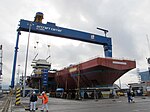Broomhall House
1702 establishments in ScotlandBuildings and structures in DunfermlineCategory A listed buildings in FifeHouse of BruceHouses completed in 1702 ... and 3 more
Houses in FifeThomas Bruce, 7th Earl of ElginUse British English from July 2015
Broomhall House is the family seat of the Earls of Elgin, three miles (4.8 kilometres) south-west of Dunfermline, sitting above the village of Limekilns and near the village of Charlestown, in Fife, Scotland. The building was designated as a Category A listed building in 1971.
Excerpt from the Wikipedia article Broomhall House (License: CC BY-SA 3.0, Authors).Broomhall House
The Old Orchard,
Geographical coordinates (GPS) Address Nearby Places Show on map
Geographical coordinates (GPS)
| Latitude | Longitude |
|---|---|
| N 56.03715 ° | E -3.48325 ° |
Address
The Old Orchard
KY11 3HS
Scotland, United Kingdom
Open on Google Maps







